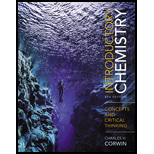
Concept explainers
(a)
Interpretation:
Two unit factors for the given metric relationships are to be stated.
Concept introduction:
The metric system unit is the unit system which is accepted as the standard system of unit internationally. The nonmetric units are the common unit system which is not standard for the parameter to be calculated. The unit factors are calculated by taking the ratio of two equivalent measurement systems.
Answer to Problem 13E
Two unit factors for the given metric relationships are
Explanation of Solution
The kilo
The relation showing unit equation between meter
The unit factors are calculated by taking the ratio of two equivalent measurement systems. Thus, the unit factor for meter
Another unit factor can be written as,
Two unit factors for the given metric relationships are
(b)
Interpretation:
Two unit factors for the given metric relationships are to be stated.
Concept introduction:
The metric system unit is the unit system which is accepted as the standard system of unit internationally. The nonmetric units are the common unit system which is not standard for the parameter to be calculated. The unit factors are calculated by taking the ratio of two equivalent measurement systems.
Answer to Problem 13E
Two unit factors for the given metric relationships are
Explanation of Solution
The mega
The relation showing unit equation between grams
The unit factors are calculated by taking the ratio of two equivalent measurement systems. Thus, the unit factor for grams
Another unit factor can be written as,
Two unit factors for the given metric relationships are
(c)
Interpretation:
Two unit factors for the given metric relationships are to be stated.
Concept introduction:
The metric system unit is the unit system which is accepted as the standard system of unit internationally. The nonmetric units are the common unit system which is not standard for the parameter to be calculated. The unit factors are calculated by taking the ratio of two equivalent measurement systems.
Answer to Problem 13E
Two unit factors for the given metric relationships are
Explanation of Solution
The milli
The relation showing unit equation between liters
The unit factors are calculated by taking the ratio of two equivalent measurement systems. Thus, the unit factor for liters
Another unit factor can be written as,
Two unit factors for the given metric relationships are
(d)
Interpretation:
Two unit factors for the given metric relationships are to be stated.
Concept introduction:
The metric system unit is the unit system which is accepted as the standard system of unit internationally. The nonmetric units are the common unit system which is not standard for the parameter to be calculated. The unit factors are calculated by taking the ratio of two equivalent measurement systems.
Answer to Problem 13E
Two unit factors for the given metric relationships are
Explanation of Solution
The micro
The relation showing unit equation between seconds
The unit factors are calculated by taking the ratio of two equivalent measurement systems. Thus, the unit factor for seconds
Another unit factor can be written as,
Two unit factors for the given metric relationships are
Want to see more full solutions like this?
Chapter 2 Solutions
Introductory Chemistry: Concepts and Critical Thinking Plus MasteringChemistry with eText -- Access Card Package
- State the nomenclature for prefixes used to examine large and small measurements in scientific notation?arrow_forwardDefine the term unit conversion problems?arrow_forwardComplete the following table by filling in the blanks in each row with the name of the metric unit, the property being measured (mass, length, volume), and/or the abbreviation for the metric unit. The first row has been completed as an example.arrow_forward
- A bicycle accelerates from 5 miles per hour to 15 miles per hour. Does its energy increase or decrease? Is the change in potential energy or kinetic energy?arrow_forwardReferring to Table 1.3, answer the following questions: a. Which is longer, a centimeter or an inch? b. How many milliliters are in a quart? c. How many grams are in an ounce?arrow_forwardTwo cities in Germany are located 25km apart. What is the distance in miles?arrow_forward
- How do I find the original water level in a beaker, when I’m given the mass of a metal (grams) submerged in the beaker, said metals density and temperature, and the current water level that has risen because of the metal?arrow_forwardWhich physical state is described as having particles closely packed and held rigidly in position?arrow_forwardWhat is the mass of the 50-gram car, in kilograms?arrow_forward
 Chemistry for Today: General, Organic, and Bioche...ChemistryISBN:9781305960060Author:Spencer L. Seager, Michael R. Slabaugh, Maren S. HansenPublisher:Cengage Learning
Chemistry for Today: General, Organic, and Bioche...ChemistryISBN:9781305960060Author:Spencer L. Seager, Michael R. Slabaugh, Maren S. HansenPublisher:Cengage Learning Introductory Chemistry: A FoundationChemistryISBN:9781337399425Author:Steven S. Zumdahl, Donald J. DeCostePublisher:Cengage Learning
Introductory Chemistry: A FoundationChemistryISBN:9781337399425Author:Steven S. Zumdahl, Donald J. DeCostePublisher:Cengage Learning General, Organic, and Biological ChemistryChemistryISBN:9781285853918Author:H. Stephen StokerPublisher:Cengage Learning
General, Organic, and Biological ChemistryChemistryISBN:9781285853918Author:H. Stephen StokerPublisher:Cengage Learning World of Chemistry, 3rd editionChemistryISBN:9781133109655Author:Steven S. Zumdahl, Susan L. Zumdahl, Donald J. DeCostePublisher:Brooks / Cole / Cengage Learning
World of Chemistry, 3rd editionChemistryISBN:9781133109655Author:Steven S. Zumdahl, Susan L. Zumdahl, Donald J. DeCostePublisher:Brooks / Cole / Cengage Learning Introductory Chemistry: An Active Learning Approa...ChemistryISBN:9781305079250Author:Mark S. Cracolice, Ed PetersPublisher:Cengage Learning
Introductory Chemistry: An Active Learning Approa...ChemistryISBN:9781305079250Author:Mark S. Cracolice, Ed PetersPublisher:Cengage Learning





